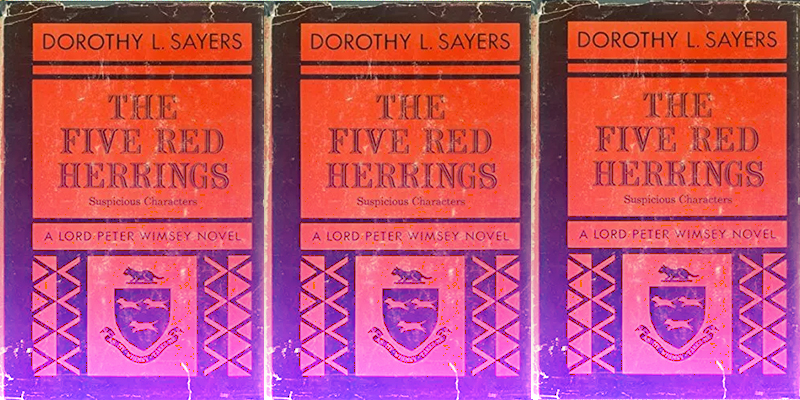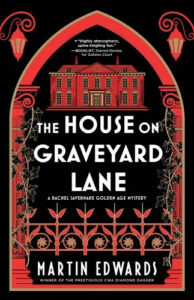Dorothy L. Sayers wrote The Five Red Herrings in 1930, at the height of the Golden Age of detective fiction. Yet the book novel (published at the start of the following year and originally known in the United States as Suspicious Characters) stands apart from her other mysteries featuring Lord Peter Wimsey. This is because she deliberately set out to write ‘a pure puzzle story’. Sayers admitted to her publisher, Victor Gollancz, that she’d been provoked ‘by a lot of reviewers’ of her previous novel, Strong Poison, ‘who observed the identity of the murderer was obvious from the start (as indeed it is also in Unnatural Death and The Documents in the Case)…but if people really want to play ‘spot the murderer’, I don’t mind obliging them – for once!’
For all her flair as a crime writer, Sayers was not particularly interested in the whodunit. As she said to Gollancz, ‘Personally, I feel that it is only when the identity of the murderer is obvious that the reader can really concentrate on the question (much the most interesting) How did he do it?’ This remains today, as it was at the time, a minority view, but it helps to explain why Sayers’ novels are so distinctive. And it has to be said that, judged as a whodunit, The Five Red Herrings is hardly a match for Agatha Christie’s twistiest mysteries. The novel’s real distinction lies in its evocation of place.
The settings of Sayers’ best books—the advertising agency in Murder Must Advertise, the Fens in The Nine Tailors, and the Oxford women’s college in Gaudy Night—are a major and enduring strength of her work. And even if there’s a certain lack of excitement in the puzzle plot of The Five Red Herrings, which focuses on the minutiae of train timetables as relentlessly as any of the alibi mysteries concocted by her Detection Club colleague Freeman Wills Crofts, her evocation of Galloway in the south west of Scotland offers ample compensation.
The secret of her success in capturing the spirit of the place lies in her meticulous attention to detail. Her rural community is infinitely more lifelike than the ‘Mayhem Parva’ type of English village which featured so often in Golden Age novels. Right from the start, we’re left in no doubt that Sayers is writing about a recognisable artists’ colony. As she says in a prefatory note: ‘All the places are real places…and all the landscapes are correct, except that I have run up a few new houses here and there’. An attractive and lavishly detailed map of the area helps readers to follow the action.
Sayers became familiar with Galloway following her marriage. Her husband, ‘Mac’ Fleming, was a Scot who enjoyed painting and felt drawn to that part of the world. The couple holidayed in Gatehouse of Fleet, staying at the Anwoth Hotel, and Sayers became friendly with the landlord, Joe Dignam. So friendly, in fact, that she dedicated The Five Red Herrings to him, and was greatly distressed by his early death, less than three years after the book was published.
From 1929 onwards, Sayers and Mac stayed in another small town not far from Gatehouse. This was Kirkcudbright, and until the Second World War, Mac Fleming had a tenancy of No. 14a High Street, giving his occupation on the valuation roll as ‘artist’. The particular appeal to him of Kirkcudbright was that the town had been a magnet for artists since the late nineteenth century and was home to a number of leading painters, including Charles Oppenheimer, whose house was next door and who became a good friend, and Edward Atkinson Hornel, who lived a few strides away on the same side of High Street, in an impressive pink Georgian building known as Broughton House. Another local artist, Helen Stirling Johnson, painted a portrait of Sayers, and some of her sketches for this were used in the publicity around the publication of The Five Red Herrings – one of many examples of Sayers’ clever use of the expertise she’d gained from working in advertising to market her books.
It’s more than likely that aspects of the personalities of the people Sayers met in Galloway seeped into her portrayal of the characters in the novel. Her fetish for technical accuracy led her to check a vital plot point connected with an alibi by accompanying Mac in a hair-raising drive: as she wrote to a correspondent who queried the alibi: ’80 mph along the Gatehouse-Kirkcudbright road is quite correct. My husband has done it, but I can assure you that it is not comfortable to be the passenger on such an occasion.’
But for me, and for countless other readers over the years, the primary appeal of The Five Red Herrings lies in the way she brings the setting to life. And as a writer of detective fiction I have, like many other colleagues, learned a good deal from Sayers’ insistence on first-hand research and her methods for creating an authentic rural background through the careful use of a selection of telling details. In my latest Rachel Savernake mystery, The House on Graveyard Lane (published in the UK as Sepulchre Street), I’ve deployed these techniques when describing the lovely and ancient town of Rye and the eerie landscape of Romney Marsh, at the south east corner of England. As Sayers did in Galloway, I enjoyed wandering round the area where I planned to set the story, talking to local people and trying to gain as clear an understanding as possible of the communities I wanted to present.
On a recent pilgrimage to Galloway, I had the pleasure of following in Sayers’ footsteps in gloriously sunny weather. As you drive into Kirkcudbright, a tourist welcome sign leaves you in no doubt that this is still very much an ‘Artists’ Town’. No. 14a High Street is still there, looking very smart. Broughton House (which served as home to one of the suspects in the 1975 TV version of the story, starring Ian Carmichael) is now in the care of the National Trust of Scotland, with Hornel’s studio in the basement open to visitors. And there are still ‘little homely studios…tucked away down narrow closes’, as Sayers describes in the opening paragraphs of her book. A few miles away is Gatehouse in Fleet. The Anwoth Hotel is now a ‘boutique hotel’ known the Ship Inn, with Sayers mentioned on the website, while the Mill on the Fleet nearby is an impressive visitor centre which again makes the connection between the locality and The Five Red Herrings. A truly impressive legacy for a single novel. But one thing is for sure. I’d never fancy driving along those narrow, winding roads at anything like eighty miles per hour – not even if I were trying to establish an alibi for a murder!
***


















